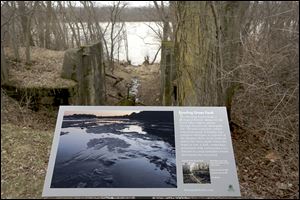
Company says anti-pipeline move too late
Group says northwest Ohio is too prone to earthquakes
2/17/2017Houston-based Spectra Energy argues it’s too late for a newly formed citizens group to argue northwest Ohio is too earthquake-prone for the $2 billion, 257-mile NEXUS Gas Transmission pipeline project, and urged federal regulators to dismiss the group’s request for a hearing.
In a nine-page filing with the Federal Energy Regulatory Commission, Spectra’s lawyers said a citizens group called United Communities for Protecting our Water and Elevating Power, “has failed to present good cause as to why it should be allowed to intervene.”

A plaque provided by the Metroparks identifies the area where the Bowing Green Fault runs through Farnsworth Metropark and across the Maumee River.
They also described the group’s hearing request as “tardy” and “frivolous.”
“If UC4POWER had a concern with the Bowling Green Fault, it — like other commenters [sic] on the project — had ample opportunities to seek party status and raise its concern,” the pipeline company said in its response. “UC4POWER should not be allowed to wait on the sidelines without participating in scoping or comment periods, then seek late intervention, and party status, only when it disagrees with the final analysis of the [final environmental impact statement].”
UC4POWER did not exist when hearings were held.
The group, relying on a visual observation along a paved trail of a Metroparks of the Toledo Area marker and research by Bowling Green State University researcher Andrew Kear, has urged FERC to hold a hearing on the region’s seismic potential, which members argue was overlooked by the company.
The marker, located in Farnsworth Metropark near the Roche de Boeuf parking lot, states that the 100-mile fault — which goes from Findlay to southeast Michigan — is so close to the surface it can be visible to the human eye in that part of northwest Ohio when the Maumee River’s running low.
Spectra, developing the project with DTE Energy and others, has said in documents it provided to FERC that it believes the fault is 2,200 feet or more below Earth’s surface — nearly a half-mile below ground. That information was used in the project’s final environmental impact statement, which asserts the proposed route does not include earthquake-prone areas.
The project is being developed to move natural gas extracted from fracked shale in southern Ohio to southwest Ontario.
Mr. Kear, a Bowling Green State University assistant professor who specializes in geology and environmental policy issues, said at a Feb. 8 rally the Waterville area is one of the “worst possible” places for such a pipeline because of its seismic potential and porous karst geology.
“The time to act is now, before the pipeline goes in,” Mr. Kear said back then while standing near the banks of the Maumee River, outside the Roche de Boeuf visitors center, next to about 50 sign-carrying demonstrators. “If we’re having this problem here, what other problems are they having along the route?”
Mr. Kear was joined by UC4POWER spokesman Lisa Kochheiser and Terry Lodge, a Toledo attorney representing the group.
A company spokesman, Adam Parker, has reiterated the company’s position that the pipeline will be built safely and without risk to the environment.
Contact Tom Henry at: thenry@theblade.com, 419-724-6079, or via Twitter @ecowriterohio.